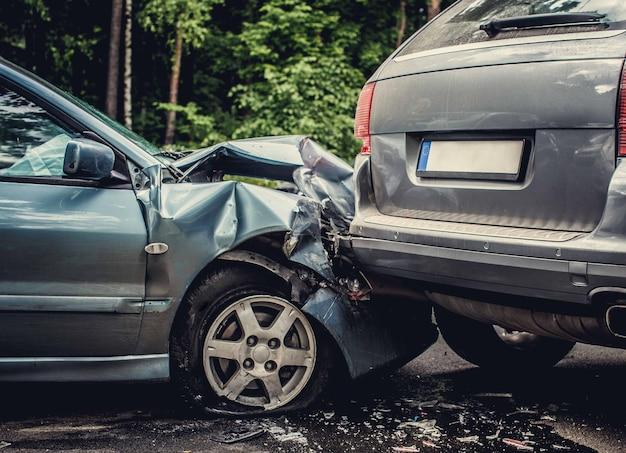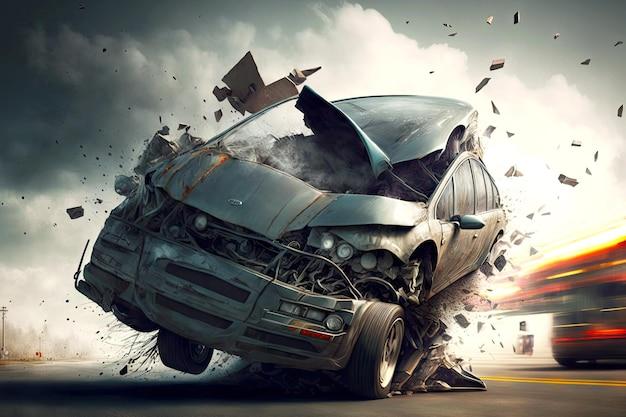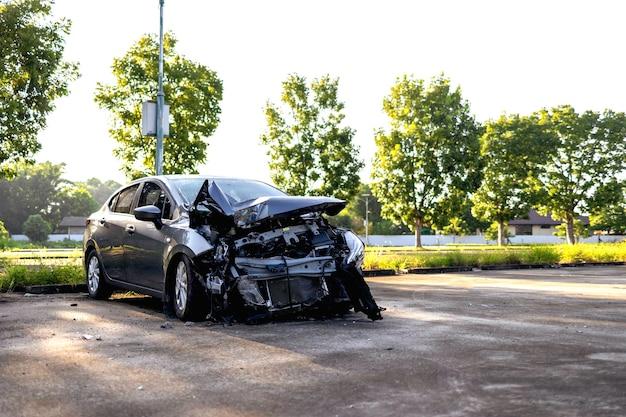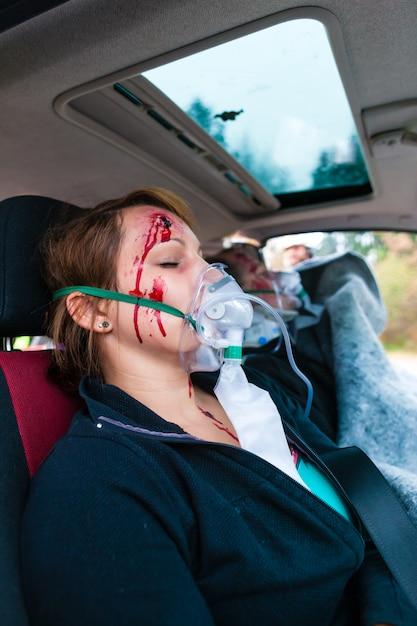Car accidents can be devastating, causing various types of injuries. One particular type of injury that often occurs in these situations is blunt force trauma. You may have heard the term before, but what does it really mean? In this blog post, we will delve into the world of blunt force trauma from car accidents and explore its definition, its different forms, and its potential consequences. Whether you have experienced it firsthand or are simply curious about the topic, join us as we uncover the details of this often-fatal consequence of vehicular collisions.
Blunt Force Trauma from Car Accidents
Introduction
Hey there, fellow readers! Today, we’re diving into the world of blunt force trauma from car accidents. Buckle up and get ready for some fascinating information about the consequences of these unfortunate events.
What Exactly is Blunt Force Trauma
Alright, let’s start from the basics. Blunt force trauma refers to the injuries sustained when a physical object strikes the body with significant force but doesn’t penetrate the skin. In the context of car accidents, this usually occurs when the vehicle abruptly comes to a halt, causing passengers to collide with the interior of the car or even get ejected forcefully. Ouch!
It’s All About the Impact
Now, let’s talk about the impact of this kind of trauma. When a car suddenly stops, your body will continue moving until it meets an obstacle, such as the steering wheel, dashboard, or perhaps a fellow passenger. That sudden deceleration can have a devastating effect on your internal organs, bones, and tissues. It’s like a chaotic rollercoaster ride, minus the thrill.
Unmasking the Injuries
Once the dust settles, various injuries might rear their ugly heads due to this blunt force trauma. Head injuries are one of the most common and can range from minor concussions to severe brain damage. Brace yourself for the possibility of fractures, broken bones, dislocated joints, and internal bleeding too. These injuries may not always be immediately obvious, so don’t underestimate the importance of seeking medical attention after a car accident.
The Aftermath and Long-term Effects
Now, let’s look at the aftermath of blunt force trauma. The road to recovery can be long and challenging, depending on the severity of the injuries sustained. Along with physical pain, individuals may experience emotional trauma, anxiety, and even post-traumatic stress disorder (PTSD). It’s essential to have a strong support system in place and seek professional help when needed.
Prevention is Key
We can’t turn back time, but we can take preventative measures to reduce the risk of blunt force trauma from car accidents. Buckling up that seatbelt is a no-brainer, my friends! Additionally, make sure child passengers are appropriately secured in car seats or boosters, and always follow traffic rules. Remember, caution on the road saves lives.
Now that we’ve reached our destination, it’s time to unpack our knowledge on blunt force trauma from car accidents. We’ve explored the ins and outs of this unfortunate consequence, learned about the impact, unmasked the injuries, and discussed the aftermath. By understanding the risks and taking preventive measures, we can strive for safer roads and minimize the occurrence of such traumatic events. Stay safe out there, and see you on the next ride!
Blunt Force Trauma: Understanding the Definition
Blunt force trauma from a car accident can have severe consequences, but what exactly does “blunt force” mean? In this section, we’ll delve into the definition of blunt force and how it relates to car accidents. So grab your seatbelt, and let’s get started!
Defining Blunt Force
Blunt force refers to an impact or blow delivered by a blunt object. In the case of car accidents, it’s the force exerted on the body due to the collision. Picture this: you’re cruising down the road, minding your own business, and suddenly bam, your car collides with another vehicle. That abrupt collision creates a powerful force, resulting in blunt force trauma.
The Power of Blunt Force in Car Accidents
Car accidents are like a chaotic dance between motion and inertia. When two vehicles collide, their velocity transforms into a destructive force. This force, also known as kinetic energy, can be transferred to the passengers inside the cars. This is where blunt force trauma comes into play.
Now, imagine your body as a crash test dummy (minus the fancy suit). During the collision, your body becomes the battleground of forces. As the two cars meet, your body tries to resist the change in motion, but ultimately succumbs to the powerful impact. It’s this sudden change in momentum that leads to blunt force trauma.
The Hidden Dangers of Blunt Force Trauma
Blunt force trauma in car accidents can result in various injuries, ranging from mild to life-threatening. The force of impact can cause fractures, concussions, internal bleeding, and even organ damage. So, it’s no joke. Even seemingly minor accidents can deliver a strong blow, leaving you with unexpected injuries and pain.
Protecting Yourself from Blunt Force Trauma
While we can’t control other drivers on the road, we can take steps to minimize the risk of blunt force trauma. Wearing seat belts, using properly installed car seats, and ensuring airbags are in working condition can significantly reduce the impact of a collision. It’s also essential to follow traffic rules, maintain a safe distance from other vehicles, and drive defensively.
Now that we’ve explored the definition of blunt force trauma, it’s clear that car accidents unleash a force to be reckoned with. Understanding the power behind these collisions can help us appreciate the importance of safe driving practices and taking precautionary measures. So, next time you hop into your car, remember to buckle up and keep an eye out for those unexpected blows. Stay safe on the road!
Can a Fall Cause Blunt Force Trauma
Blunt force trauma typically refers to injuries caused by a forceful impact to the body. While car accidents are commonly associated with this type of trauma, you might be wondering if a fall can also lead to such injuries. Well, the answer is a resounding yes! Let’s dig deeper into how falls can cause blunt force trauma.
Understanding Blunt Force Trauma
Before we delve into the connection between falls and blunt force trauma, it’s essential to grasp what blunt force trauma entails. This type of injury occurs when an object or force strikes the body, causing damage without penetrating the skin. Common mechanisms include vehicle collisions, falls, physical assaults, or sports injuries.
The Severity of the Impact
The severity of a fall determines whether it can result in blunt force trauma. From a minor slip to a significant stumble, falls can vary widely in intensity. In general, a fall becomes more likely to cause blunt force trauma when it involves a significant height, a sharp or rigid object, or a forceful impact upon landing.
Factors at Play
Factors such as surface hardness, body position during the fall, and the age and health of the individual also play a role in determining the likelihood and severity of blunt force trauma. For instance, falling onto a concrete sidewalk may have more severe consequences than landing on a cushioned surface.
Vulnerable Areas
Certain areas of the body are more susceptible to blunt force trauma during a fall. These include the head, neck, spine, chest, abdomen, pelvis, and extremities. Depending on the force and the body part affected, injuries may range from mild bruises and contusions to fractures, internal organ damage, or even concussions.
The Importance of Seeking Medical Attention
Considering the potential seriousness of blunt force trauma, it is crucial to seek medical attention after experiencing a fall, particularly if you suspect any underlying injuries. Even seemingly minor falls can result in serious internal injuries that may not be immediately apparent. Therefore, it’s always better to err on the side of caution and get a thorough medical evaluation.
While car accidents are often associated with blunt force trauma, falls can also lead to these types of injuries. The severity of a fall, along with various other factors, can determine the likelihood and extent of blunt force trauma. Remember, taking any fall seriously and seeking medical attention promptly is crucial for ensuring your well-being. Stay safe and try to avoid those clumsy moments!
Does Blunt Force Trauma Kill Instantly
Blunt force trauma from car accidents can cause severe injuries, but does it always result in instant death? Let’s explore this question and shed light on the effects of blunt force trauma on the human body.
The Mechanics of Blunt Force Trauma
Blunt force trauma refers to the injuries caused by a blunt object or force, such as the impact of a car collision. When a car hits another car or an object, the force is transferred through the body, causing damage to organs, bones, and tissues.
Severity of Injuries
The severity of injuries caused by blunt force trauma varies depending on multiple factors. These factors include the speed of the vehicles involved, the angle of impact, and the use of safety equipment like seatbelts and airbags. In some cases, the injuries may be minor, while in others they can be life-threatening.
Survivability of Blunt Force Trauma
Contrary to popular belief, blunt force trauma does not always result in instant death. While severe cases can lead to fatalities, survivability is possible depending on the severity and location of the injuries. The body’s resiliency and medical intervention also play crucial roles in determining the outcome.
Immediate Actions After an Accident
If you or someone you know is involved in a car accident, it is important to take immediate action. Calling emergency services and seeking medical attention is essential, as internal injuries may not always be visible. Prompt medical evaluation can increase the chances of survival and minimize long-term complications.
Medical Interventions and Rehabilitation
Medical interventions after blunt force trauma aim to stabilize the patient, control bleeding, and address any critical injuries. Surgeons may perform emergency procedures to repair damaged organs or stop internal bleeding. In cases of severe trauma, rehabilitation programs may be necessary to aid in the recovery process.
Long-Term Effects and Complications
Survivors of blunt force trauma may face long-term effects and complications. These can include chronic pain, limited mobility, psychological trauma, and post-traumatic stress disorder (PTSD). Rehabilitation, therapy, and support from loved ones can help survivors navigate the challenges they may encounter.
While blunt force trauma from car accidents can have devastating consequences, it does not always result in instant death. The survivability of such injuries depends on various factors, including the severity of the trauma and the promptness of medical intervention. Understanding the mechanics, seeking immediate help, and providing ongoing support can make a positive difference in the lives of survivors.
What is an Example of Blunt Force Trauma
Blunt force trauma is a term that sounds like something straight out of an action movie. But in reality, it refers to a serious injury caused by a strong impact to the body. It can occur in a variety of situations, including car accidents. Let’s take a closer look at an example of blunt force trauma and how it can affect the body.
A Crushing Blow
Imagine you’re driving down the street when suddenly, out of nowhere, another vehicle collides with your car. The impact is forceful, causing your body to jolt forward and then violently snap back. This sudden and powerful motion can lead to blunt force trauma.
The Consequences of Impact
When your body experiences blunt force trauma in a car accident, several things can happen. One common result is broken bones. The force of the impact can be so intense that it fractures or shatters bones, causing immense pain and limited mobility. In severe cases, surgery may be required to realign and stabilize the broken bones.
Internal Injuries
Blunt force trauma from a car accident can also cause internal injuries. The impact of the collision can damage organs such as the liver, spleen, or kidneys, leading to bleeding and potential organ failure. These injuries may not be immediately apparent and can worsen over time if left untreated.
The Tricky Traumatic Brain Injury
One of the most concerning consequences of blunt force trauma in a car accident is the risk of a traumatic brain injury (TBI). The brain, being a delicate organ, can suffer significant damage from the forces exerted during impact. TBIs can range from mild concussions to severe brain damage, with symptoms ranging from headaches and dizziness to memory loss and impaired cognitive function.
Seeking Medical Attention
If you or someone you know has experienced blunt force trauma from a car accident, it’s crucial to seek medical attention promptly. Even seemingly minor injuries can have long-term effects if not properly treated. A healthcare professional can assess the extent of the trauma and provide appropriate care and treatment options.
In conclusion, blunt force trauma resulting from a car accident can have far-reaching effects on the body. From broken bones to internal injuries and the risk of traumatic brain injury, the impact of such an event can be devastating. Remember to always prioritize safety and seek medical attention to ensure the best possible outcome in the face of such injuries. Stay safe on the roads!
Severe Blunt Force Trauma to the Lower Extremities
Causes and Impact of Severe Blunt Force Trauma
When it comes to car accidents, one of the most common injuries individuals suffer from is severe blunt force trauma to the lower extremities. This type of injury occurs when a significant amount of force is applied to the legs, resulting in fractures, dislocations, and severe tissue damage. Let’s take a closer look at the causes of this injury and how it can impact individuals.
High-Speed Collisions: Not a Smooth Ride
High-speed collisions can be particularly brutal on the lower extremities. When two vehicles collide at a high rate of speed, the energy from the impact transfers directly to the passengers’ bodies. The legs, being closest to the point of impact, often bear the brunt of the force. The result? Severe blunt force trauma that can have a lasting impact on a person’s quality of life.
Crushing Forces: Crushed Hopes
Another common cause of severe blunt force trauma to the lower extremities is when a car is crushed or pinned in an accident. Imagine being trapped in a vehicle that is severely damaged, and your legs being caught in the debris. The crushing forces from the twisted metal can cause unimaginable damage to the legs, resulting in severe injuries.
The Aftermath: Pain, Recovery, and Resilience
Intense Pain: Ouch!
Immediately after the accident, individuals often experience intense pain in their lower extremities. The force of impact can cause fractures, dislocations, and severe damage to the tissues in the legs. The pain can be excruciating and may require strong pain medication to manage.
Long Road to Recovery: One Step at a Time
Recovering from severe blunt force trauma to the lower extremities is no walk in the park. It often involves a long and arduous journey of surgeries, physical therapy, and rehabilitation. Depending on the severity of the injury, individuals may need to relearn how to walk, which can be both challenging and frustrating.
Resilience: Bouncing Back Stronger
Despite the hardships, many individuals who have suffered severe blunt force trauma to their lower extremities have shown remarkable resilience. With the help of skilled medical professionals and unwavering determination, they work hard to regain their mobility and independence. It is truly inspiring to witness their strength and determination to overcome such a traumatic experience.
Severe blunt force trauma to the lower extremities is a significant concern in car accidents. It can result in severe injuries, intense pain, and a long road to recovery. However, with the right support and a resilient spirit, individuals can bounce back and regain their quality of life.
How Much Blunt Force Trauma to the Head Can Cause Death
Understanding the Impact
Blunt force trauma to the head is no laughing matter – it can have severe consequences, including death. When it comes to determining how much force is needed to cause such a tragedy, there are a few key factors to consider.
The Force Factor
The force required to cause fatal blunt force trauma to the head can vary depending on several factors, such as the individual’s age, physical condition, and the nature of the impact. For example, a person’s skull density can play a role in determining the amount of force required. Additionally, the angle at which the head is struck can also impact the severity of the injury.
It’s Not All about Force
While the amount of force is undoubtedly a significant factor, it’s important to note that the specific area of impact on the head is equally crucial. The brain is a complex organ, and different areas can respond differently to trauma. A blow to certain regions, such as the temple or the base of the skull, can be particularly dangerous and increase the likelihood of a fatal injury.
The Individual’s Threshold
Each person’s tolerance for blunt force trauma to the head varies. Some individuals may be more susceptible to injury, even with less force, while others may show more resilience. Factors such as overall health, pre-existing conditions, and previous injuries can influence a person’s threshold for fatal trauma.
Seeking Medical Attention Promptly
If there’s any doubt or concern regarding the severity of head trauma, it’s crucial to seek immediate medical attention. The damage caused by blunt force trauma may not be immediately apparent, and only a healthcare professional can adequately assess the situation.
The Importance of Safety Measures
While accidents happen, taking precautions can significantly reduce the risk of blunt force trauma to the head. It’s important to wear seat belts in vehicles, use appropriate safety gear when playing sports or engaging in activities that pose a risk of head injury, and be mindful of potential hazards in our surroundings.
Concluding Thoughts
Blunt force trauma to the head is a serious matter that, in certain cases, can lead to death. The amount of force required to cause a fatal injury can vary depending on factors such as skull density, impact angle, and the area struck. However, regardless of the specific circumstances, it is always important to prioritize safety and seek medical attention if there is any indication of head trauma. Remember, an ounce of prevention is worth a pound of cure when it comes to protecting against the potentially devastating consequences of blunt force trauma.
What is Blunt Force Trauma to the Head in a Car Accident
Blunt force trauma to the head in a car accident is no laughing matter, but understanding what it entails can shed light on the severity of such an injury. So, let’s put on our investigative hats and explore this topic further.
Understanding the Impact
When a car collides with another object or comes to a sudden stop, the force exerted upon the vehicle can be immense. This force can cause the occupants’ bodies to experience rapid deceleration or sudden changes in direction. Unfortunately, this violent motion can lead to blunt force trauma to the head.
The Brain Takes a Beating
Our precious brains are housed within the skull for protection, but even this fortress has its limits. During a car accident, the sudden jolt or impact can cause the brain to collide with the hard interior of the skull, resulting in blunt force trauma. It’s like the brain playing a high-stakes game of bumper cars, but with serious consequences.
The Aftermath
Blunt force trauma to the head can result in various injuries, ranging from mild to severe. Common injuries include concussions, hemorrhages, contusions, and skull fractures. The severity of these injuries depends on the force of the impact, the angle of the collision, and the overall health of the individual involved.
Signs and Symptoms
Recognizing the signs and symptoms of blunt force trauma to the head is crucial for seeking timely medical attention. These can include dizziness, confusion, memory problems, headaches, nausea, and even changes in personality. Remember, seeking medical attention is always the smartest move—better to be safe than sorry!
The Road to Recovery
Recovering from blunt force trauma to the head can be a lengthy process. Treatment options may involve medication, rest, physical therapy, or in severe cases, surgery. Every individual’s journey to recovery is unique, and it’s essential to be patient and follow medical advice to maximize the chances of a full recovery.
Stay Safe, Buckle Up!
Prevention is key when it comes to car accidents and blunt force trauma. Always make sure to buckle up before hitting the road. Wearing a seatbelt significantly reduces the risk of serious head injuries in the event of an accident. So, let’s all be responsible road warriors and take that extra second to buckle up—it might just save a life!
In conclusion, blunt force trauma to the head in a car accident is a serious matter that should never be taken lightly. By understanding the impact, signs, symptoms, and recovery process, we can work towards creating a safer road environment for everyone. Remember, safety first, buckle up, and let’s keep our noggins intact!



